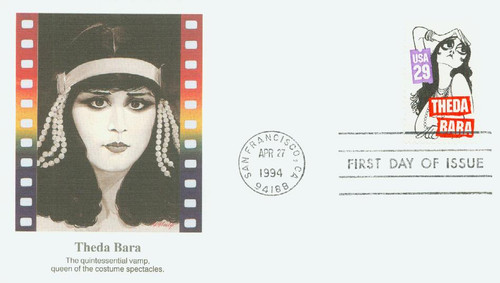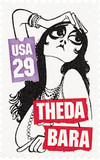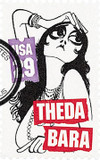
1994 29c Silent Screen Stars: Theda Bara
# 2827 - 1994 29c Silent Screen Stars: Theda Bara
$1.40 - $3.20
U.S. #2827
1994 Theda Bara
- Honors one of the legendary stars of the Silent Film Era
- Designed by famed caricaturist Al Hirschfeld
Stamp Category: Commemorative
Set: Silent Screen Stars
Value: 29c
First Day of Issue: April 27, 1994
First Day City: San Francisco, CA
Quantity Issued: 1,860,000
Printed By: Bureau of Engraving and Printing
Printing Method: Lithographed and engraved
Format: Vertical stamps issued se-tenant with nine other silent film stars in four panes of 40 stamps
Perforations: 11.2
Why the stamp was issued: Issued as part of the Silent Screen Stars set of 10. Honors the great names of the early days of Hollywood movie-making. Fulfilled the then-current First-Class postage rate.
About the stamp design: The stamp was designed by renowned artist Al Hirschfeld. Art director and typographer was Howard Paine. The artist used the same caricature style as his earlier work on the Comedians se-tenant booklet pane of five. Hirschfeld’s style captures the main characteristics of Theda Bara’s screen persona. The 29c denomination was printed in drop-out type on a stylized torn ticket stub. The actress’ stamp features her name in white lettering against a red background shaped like another ticket remnant, carrying out the movie motif. Red and purple colors add vibrancy to the black and white caricatures.
First Day of Issue Ceremony: The Castro Theater in San Francisco was the site of the First Day Ceremony, with actor Karl Malden as its main speaker.
Unusual fact about this stamp: The artist was asked to work his daughter Nina’s name into his caricatures, as he had often done in previous drawings. In Theda Bara’s case, her “Nina” appears on the strands at the bottom left side of her hair.
About the Set: Besides Theda Bara, the Silent Screen Stars set includes nine other prominent stars of the Silent Screen era: “The Sheik” Rudolf Valentino, “It Girl” Clara Bow, “The Little Tramp” Charlie Chaplin, “Man of a Thousand Faces” Lon Chaney, plus John Gilbert, Zasu Pitts, Harold Lloyd, Keystone Cops, and Buster Keaton. Several of the images include the artist’s familiar “Nina” in honor of his daughter.
The history behind the stamp: To millions of moviegoers, Theda Bara was evil incarnate. Fatally alluring with her death-white face, snaky black hair, and heavy-lidded eyes, she seemed born to trap unwary males and lure them to their destruction.
Moving to Hollywood as an extra, Theda Bara began her film career in 1915 with the movie A Fool There Was, an adaption of Rudyard Kipling’s poem “The Vampire.” Released with an intense publicity campaign, the film made her an overnight success and established her as “The Vamp.” Within three years she had made more than 40 films.
Rumored to be the daughter of a French painter and his Egyptian mistress, her name was said to be an anagram for Arab Death. In reality though, Theda Bara was a young lady named Theodosia Goodman from Cincinnati, Ohio, whose main ambition was to be a conventional romantic heroine. However, Kathleen Mavourneen (1919), her one attempt at a role other than the irresistible, heartless woman, was a resounding flop.
About the artist:
Legendary illustrator Albert Hirschfeld was born on June 21, 1903, in St. Louis, Missouri. Hirschfeld’s work was so iconic, the USPS broke their own rules to feature his illustrations on two sets of stamps…
Hirschfeld spent the first 12 years of his life in St. Louis before his family moved to New York City in 1915. There, he attended the National Academy of Design. When he was just 17 years old, he was made art director at Selznick Pictures. He remained there for four years before going to Paris and London to study painting, drawing, and sculpture.
Upon Hirschfeld’s return to the US, his friend, Broadway press agent Richard Maney, showed some of the artist’s drawings to an editor from the New York Herald Tribune. The editor was impressed with Hirschfeld’s work and began offering him commissions for illustrations. Soon, his illustrations were being featured in the Sunday edition of The New York Times, and became a weekly staple for decades.
In 1945, Hirschfeld and his wife, Dolly, had a daughter named Nina. After her birth, the artist hid her name in the hair, clothes, or background of his drawings. Often “Nina” would be hidden in several spots and Hirschfeld would write a number next to his signature to let people know how many to look for.
Hirschfeld became known for his signature style – black and white caricatures with exaggerated features. While he was best known for his black and white drawings, he also produced many full-color paintings for magazine covers such as TV Guide, Life, American Mercury, Look, The New York Times, The New Masses, and Seventeen. Hirschfeld also provided color illustrations for several books, including Harlem As Seen By Hirschfeld, which included text written by William Saroyan.
Hirschfeld specialized in illustrations of Broadway actors, singers, and dancers that were featured in the newspaper shortly before opening night. But he illustrated famous people from all walks of life – politicians, TV stars, movie stars, jazz musicians, rock stars, and more. Hirschfeld illustrated several movie posters for Charlie Chaplin films and The Wizard of Oz. He also provided the artwork for the 1977 Aerosmith album Draw the Line. His work was a major inspiration for the “Rhapsody in Blue” segment of Disney’s Fantasia 2000, and he was a consultant on that project. His work was also reportedly influential on the design of the genie in Disney’s 1992 film, Aladdin.
In 1987, the USPS reached out to Hirschfeld to ask if he’d be interested in illustrating Broadway, Hollywood, vaudeville, radio, and television stars for future stamps. Hirschfeld was excited by the idea and accepted the commission. The Citizens’ Stamp Advisory Committee sent him several names and they loved all of his illustrations, telling him to “keep them coming.” The USPS was so excited to work with Hirschfeld, they broke some of their own rules. They normally didn’t allow hidden messages on US stamps. But postal officials wanted Hirschfeld to include as many hidden “Nina’s” as he could, because otherwise they wouldn’t be real Hirschfeld caricatures. And while he wasn’t allowed to sign his name on each stamp, they did include his name on the booklet cover, calling the set “Comedians by Hirschfeld.”
Hirschfeld had created dozens of illustrations for the USPS. In 1994, they issued a second set of stamps featuring his work honoring Silent Screen Stars. Once again, he was permitted to include “Nina” in as many areas as he could. On both sets of stamps, there are some easily identifiable “Ninas” and some that are more ambiguous, which Hirschfeld called “near-Ninas.” The USPS marketing for Hirschfeld’s stamps encouraged people to count how many Ninas they could find.
During his lifetime, Al Hirschfeld received two Tony lifetime achievement awards and a National Medal of the Arts. He died on January 20, 2003, and later that year, a Broadway theater was renamed in his honor.
U.S. #2827
1994 Theda Bara
- Honors one of the legendary stars of the Silent Film Era
- Designed by famed caricaturist Al Hirschfeld
Stamp Category: Commemorative
Set: Silent Screen Stars
Value: 29c
First Day of Issue: April 27, 1994
First Day City: San Francisco, CA
Quantity Issued: 1,860,000
Printed By: Bureau of Engraving and Printing
Printing Method: Lithographed and engraved
Format: Vertical stamps issued se-tenant with nine other silent film stars in four panes of 40 stamps
Perforations: 11.2
Why the stamp was issued: Issued as part of the Silent Screen Stars set of 10. Honors the great names of the early days of Hollywood movie-making. Fulfilled the then-current First-Class postage rate.
About the stamp design: The stamp was designed by renowned artist Al Hirschfeld. Art director and typographer was Howard Paine. The artist used the same caricature style as his earlier work on the Comedians se-tenant booklet pane of five. Hirschfeld’s style captures the main characteristics of Theda Bara’s screen persona. The 29c denomination was printed in drop-out type on a stylized torn ticket stub. The actress’ stamp features her name in white lettering against a red background shaped like another ticket remnant, carrying out the movie motif. Red and purple colors add vibrancy to the black and white caricatures.
First Day of Issue Ceremony: The Castro Theater in San Francisco was the site of the First Day Ceremony, with actor Karl Malden as its main speaker.
Unusual fact about this stamp: The artist was asked to work his daughter Nina’s name into his caricatures, as he had often done in previous drawings. In Theda Bara’s case, her “Nina” appears on the strands at the bottom left side of her hair.
About the Set: Besides Theda Bara, the Silent Screen Stars set includes nine other prominent stars of the Silent Screen era: “The Sheik” Rudolf Valentino, “It Girl” Clara Bow, “The Little Tramp” Charlie Chaplin, “Man of a Thousand Faces” Lon Chaney, plus John Gilbert, Zasu Pitts, Harold Lloyd, Keystone Cops, and Buster Keaton. Several of the images include the artist’s familiar “Nina” in honor of his daughter.
The history behind the stamp: To millions of moviegoers, Theda Bara was evil incarnate. Fatally alluring with her death-white face, snaky black hair, and heavy-lidded eyes, she seemed born to trap unwary males and lure them to their destruction.
Moving to Hollywood as an extra, Theda Bara began her film career in 1915 with the movie A Fool There Was, an adaption of Rudyard Kipling’s poem “The Vampire.” Released with an intense publicity campaign, the film made her an overnight success and established her as “The Vamp.” Within three years she had made more than 40 films.
Rumored to be the daughter of a French painter and his Egyptian mistress, her name was said to be an anagram for Arab Death. In reality though, Theda Bara was a young lady named Theodosia Goodman from Cincinnati, Ohio, whose main ambition was to be a conventional romantic heroine. However, Kathleen Mavourneen (1919), her one attempt at a role other than the irresistible, heartless woman, was a resounding flop.
About the artist:
Legendary illustrator Albert Hirschfeld was born on June 21, 1903, in St. Louis, Missouri. Hirschfeld’s work was so iconic, the USPS broke their own rules to feature his illustrations on two sets of stamps…
Hirschfeld spent the first 12 years of his life in St. Louis before his family moved to New York City in 1915. There, he attended the National Academy of Design. When he was just 17 years old, he was made art director at Selznick Pictures. He remained there for four years before going to Paris and London to study painting, drawing, and sculpture.
Upon Hirschfeld’s return to the US, his friend, Broadway press agent Richard Maney, showed some of the artist’s drawings to an editor from the New York Herald Tribune. The editor was impressed with Hirschfeld’s work and began offering him commissions for illustrations. Soon, his illustrations were being featured in the Sunday edition of The New York Times, and became a weekly staple for decades.
In 1945, Hirschfeld and his wife, Dolly, had a daughter named Nina. After her birth, the artist hid her name in the hair, clothes, or background of his drawings. Often “Nina” would be hidden in several spots and Hirschfeld would write a number next to his signature to let people know how many to look for.
Hirschfeld became known for his signature style – black and white caricatures with exaggerated features. While he was best known for his black and white drawings, he also produced many full-color paintings for magazine covers such as TV Guide, Life, American Mercury, Look, The New York Times, The New Masses, and Seventeen. Hirschfeld also provided color illustrations for several books, including Harlem As Seen By Hirschfeld, which included text written by William Saroyan.
Hirschfeld specialized in illustrations of Broadway actors, singers, and dancers that were featured in the newspaper shortly before opening night. But he illustrated famous people from all walks of life – politicians, TV stars, movie stars, jazz musicians, rock stars, and more. Hirschfeld illustrated several movie posters for Charlie Chaplin films and The Wizard of Oz. He also provided the artwork for the 1977 Aerosmith album Draw the Line. His work was a major inspiration for the “Rhapsody in Blue” segment of Disney’s Fantasia 2000, and he was a consultant on that project. His work was also reportedly influential on the design of the genie in Disney’s 1992 film, Aladdin.
In 1987, the USPS reached out to Hirschfeld to ask if he’d be interested in illustrating Broadway, Hollywood, vaudeville, radio, and television stars for future stamps. Hirschfeld was excited by the idea and accepted the commission. The Citizens’ Stamp Advisory Committee sent him several names and they loved all of his illustrations, telling him to “keep them coming.” The USPS was so excited to work with Hirschfeld, they broke some of their own rules. They normally didn’t allow hidden messages on US stamps. But postal officials wanted Hirschfeld to include as many hidden “Nina’s” as he could, because otherwise they wouldn’t be real Hirschfeld caricatures. And while he wasn’t allowed to sign his name on each stamp, they did include his name on the booklet cover, calling the set “Comedians by Hirschfeld.”
Hirschfeld had created dozens of illustrations for the USPS. In 1994, they issued a second set of stamps featuring his work honoring Silent Screen Stars. Once again, he was permitted to include “Nina” in as many areas as he could. On both sets of stamps, there are some easily identifiable “Ninas” and some that are more ambiguous, which Hirschfeld called “near-Ninas.” The USPS marketing for Hirschfeld’s stamps encouraged people to count how many Ninas they could find.
During his lifetime, Al Hirschfeld received two Tony lifetime achievement awards and a National Medal of the Arts. He died on January 20, 2003, and later that year, a Broadway theater was renamed in his honor.











